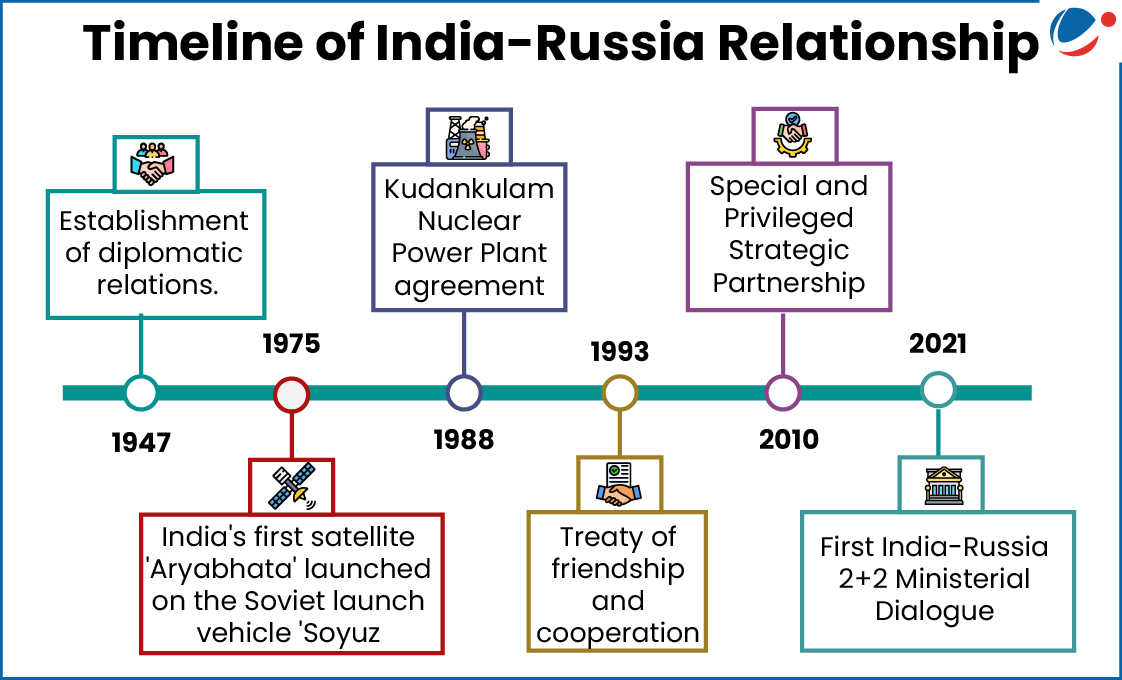Why in the News?
Recently, the 25th anniversary of the Declaration of Strategic Partnership between Russia and India has been celebrated.

More on the News
- The Declaration was signed in the year 2000.
- Since then, 22 annual summits, regular leader-level meetings, ministerial dialogues and working groups across sectors have institutionalised the partnership, ensuring continuity and depth.
- It established a qualitatively new framework that elevated bilateral cooperation across political, security, economic, defence, and cultural spheres.
Core pillars of the India-Russia partnership:
- Political and Diplomatic Convergence: Annual summit is at its centrepiece. Beyond summits, the two nations coordinate closely through ministerial exchanges, the 2+2 dialogue, and forums like UN, G20, BRICS, SCO etc.

- Russia also backs India's bid for a permanent seat on the UN Security Council.
- Defence and Security: Russia is India's top military supplier accounting for 36% of total defence imports during 2020-24 (SIPRI Report). E.g., S400 air defence system, MiG-29K naval fighter aircraft, etc.
- Defence ties have evolved from a buyer-seller model to joint research, development, and production of advanced defence technologies. E.g., BrahMos Cruise Missiles
- Conducts military exercise INDRA and Avia Indra.
- Energy Security:
- Russia is the largest crude oil supplier to India. It supplies oil at discounted prices which has helped in curbing inflation.
- Some of India's largest state-owned and private companies have invested in the Russian Far East (RFE), including ONGC's investments in oil and gas project.
- Promotes nuclear energy development. E.g., Kudankulam Nuclear Power Plant, Tamil Nadu.
- Trade and Economic: Bilateral trade between both countries reached a record high of USD 68.7 billion in FY 2024-25.
- They have set a target to take bilateral trade to $100 billion (by 2030).
- Major items of export from India include pharmaceuticals, organic and inorganic chemicals, iron & steel etc.
- 90% trade between Russia and India is conducted in local currencies i.e. rubles and rupee.
- Connectivity: Russia can enhance India's connectivity with Central Asia and the wider Eurasia through projects like the International North-South Transport Corridor (INSTC), Northern Sea Route and Chennai-Vladivostok Eastern Maritime Corridor.
- Enhances Technological Capability: E.g., In Space sector, it is assisting first crewed space mission, Gaganyaan.
- Cultural and people-to-people ties: Indian cinema once captivated Soviet audiences, Russian ballet continues to find fans in India, and yoga enjoys wide popularity across Russia - building long-lasting goodwill.
Challenges in the India–Russia Relations
- Trade Imbalance: Trade balance favors Russia. Indian imports from Russia are about of USD 63.84 billion in FY 2024-25, while exports stood at USD 4.88 billion.
- Rupee Surplus Problem: Trade imbalance has generated financial challenges as billions of Indian rupees have accumulated in Special Rupee Vostro Accounts (SRVAs) in Indian banks.
- The Russian Foreign Minister identified this surplus as a "problem," noting Russia's inability to use these funds for international transactions outside the Western financial system.
- Declining Defence Imports: It is mainly due to diversification of India's arms import from countries like Israel, France, and the United States – along with indigenization efforts.
- Diverging Geopolitical Priorities:
- India-US convergences: India is increasingly aligning with the West, particularly the US. E.g. Security relationship such as Quad.
- Growing Russia-China ties: In 2022, Russia and China announced a "no limits" partnership outlining closer political, security, and economic engagement.
- Russia's rapprochement with Pakistan: E.g., Recent cooperation between Pakistan and Russia includes defence initiatives like joint counter-terrorism drills and naval exercises.
- Sanctions by USA: No major military deals with Russia have been concluded since the S-400 deal to avoid USA sanctions under Countering America's Adversaries through Sanctions Act (CAATSA), 2017.
- CAATSA allows the imposition of sanctions on countries dealing with three nations, i.e., Russia, Iran, and North Korea.
How India is balancing its relation with Russia and USA?
|
Way Forward
- Enhancing Mutual Trust: Both countries need to reinforce mutual trust amid growing apprehensions about Russia-China and India-US convergences.
- Strengthening Tier II diplomacy: Strengthening contacts with the new generation as well as academia and stationing Indian correspondents in Russia.
- Diversifying trade: Indo-Russia trade should expand beyond oil, incorporating products from traditional sectors such as IT, textile, agriculture, etc. It will promote India's export to Russia.
- Promoting Joint research & co-development: Building on past successes like BrahMos missile and AK-203 rifles, future collaboration should focus on next-generation defence technologies.
- Finalizing Free Trade Agreement (FTA) with Eurasian Economic Union (EAEU): Russia is a key member of the EAEU.
- Promote cooperation in Nuclear Energy: Russia can help India in developing Small Modular Reactors (SMRs).
- Other: Promoting Cooperation in non-traditional areas like AI, cyber security, etc.
Conclusion
The future of India–Russia relations depends on both nations' ability to adapt their partnership to emerging global realities expanding beyond defence and energy into technology, innovation, and people-to-people links.





